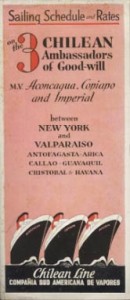S. describes the crew of the ship he finds himself on. It soon becomes apparent that these are not ordinary sailors. He notes that “there are no shouts of command, there is none of the rough repartee of the briny, there are no grunts or cries or complaints.” This “crew is silent as the dead.” Jen contrasts this to “the crew of the Ariadne [(from Straka’s Braxenholm)] – one big party until the wreck.”
As he watches the quiet crew, S. assumes he will likely have to join them at some point. This then leads him to wonder whether “he slept through the entire day” or “if he has been unconscious for longer than that.” This is the first time the reader is introduced to the time distortion aboard the ship. The vessel’s time warp is a concept that arises several times throughout the novel.
In the margins a significant event takes place which alters Jen and Eric’s entire interpretation of the novel. Until this point, both Jen and Eric believe that FXC is an abbreviation for “Francisco Filip Xabregas Caldeira” but in going through “passenger manifests for every ship that arrived in NY from Brazil b/w 1903-1929” Jen discovers a “Filomela Xabregas Caldeira who showed up often on the crew of the Imperia – as a translator.” This is when Jen and Eric learn that Straka’s translator is a female and it is also the first time they can consider that possibility that there is a love story interwoven in Straka’s mysterious life. As Eric put it, Jen’s discovery “changes everything.”
 Note: While there is no real ship called the Imperia that travelled between New York and Brazil in the early 1900’s, there was a Chilean ship called the Imperial which did travel to New York but in the early 40s. The Imperia is referenced on page 21 when Sola tells S. which ship she travelled on. This connects Sola to FXC further.
Note: While there is no real ship called the Imperia that travelled between New York and Brazil in the early 1900’s, there was a Chilean ship called the Imperial which did travel to New York but in the early 40s. The Imperia is referenced on page 21 when Sola tells S. which ship she travelled on. This connects Sola to FXC further.
In addition, Jen discovers that “on 5/15/24 there was a passenger on the Imperia named S. Opice-Tance” which is Czech for “the monkey dances.”

You must be logged in to post a comment.